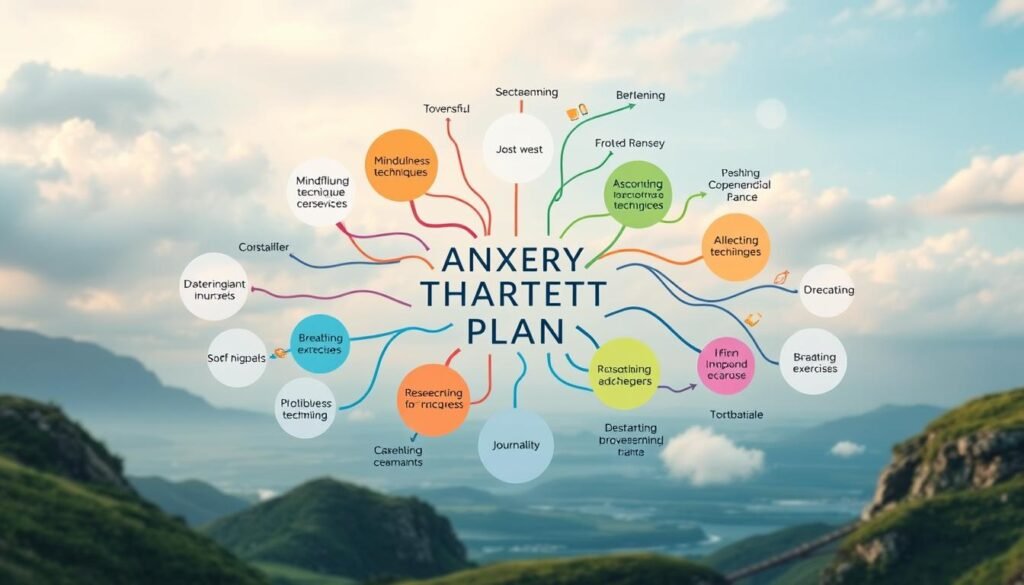Did you know about 31.1% of U.S. adults have been affected by an anxiety disorder at one time or another? Anxiety isn’t just a temporary worry. It greatly affects people of all ages, including kids and seniors dealing with life’s challenges. Knowing how counseling helps with anxiety is key for those looking for mental health guidance.
Anxiety counseling is crucial for taking back control of your life. It offers a safe space to understand anxiety’s many aspects. This includes physical signs like a fast heart rate and not being able to breathe easily, and mental patterns like fearing the worst. Getting to know what happens in anxiety counseling can clear up wrong ideas. This might stop people from getting the help they need. Counseling methods, such as cognitive-behavioral therapy (CBT) and person-centered counseling, target the emotional, thinking, and physical parts of anxiety. This helps provide thorough and tailored support.
Key Takeaways
- Anxiety affects 31.1% of U.S. adults at some point in their lives.
- Counseling provides a safe space to discuss both the physical and mental symptoms of anxiety.
- Cognitive-Behavioral Therapy (CBT) is commonly used and effective for anxiety disorders.
- Exposure therapy helps individuals face their fears in a gradual, manageable way.
- Recognizing the need for support is a proactive step in mental health care.
Understanding Anxiety and Its Impact
Anxiety touches the lives of many, with around 40 million American adults affected each year. It arises as a natural reaction to perceived dangers, helping prepare us for action. The impact of anxiety varies, showing through symptoms that disrupt life and emotional health.
The Nature of Anxiety
Anxiety has different forms, like generalized anxiety disorder and social anxiety. Each one brings its challenges. Generalized anxiety disorder, affecting about 7 million adults, involves ongoing worry. Symptoms include restlessness and irritability. Social anxiety impacts 15 million adults, causing distress in social situations and affecting relationships.
The consequences of these disorders can range from mild discomfort to severe panic attacks. This shows how complex anxiety is.
How Anxiety Affects Daily Life
The impact of anxiety extends beyond just feeling uneasy. It affects daily life, changing how we interact at work and with loved ones. Roughly 1 in 3 kids will face anxiety, highlighting the need for effective emotional health care. It leads to feelings of isolation, trouble focusing, and more stress.
To tackle this issue, many turn to therapy, medication, and self-care. For more insights into managing anxiety, check out resources at understanding anxiety.
| Anxiety Disorder | Estimated Affected Adults | Common Symptoms |
|---|---|---|
| Generalized Anxiety Disorder | 7 million | Restlessness, irritability, muscle tension |
| Social Anxiety Disorder | 15 million | Nervousness in social situations, avoidance |
| Panic Disorder | 6 million | Panic attacks, shortness of breath, trembling |
| Specific Phobias | 8-12% of individuals | Intense fear of specific objects or situations |
What to Expect in Anxiety Counseling
Knowing what happens in anxiety therapy makes clients feel ready and calm. The journey starts at the first session. Here, counselors look into each person’s situation. They set goals to create a plan that fits each client perfectly.
The Initial Counseling Session
The first meeting is about creating a bond between the client and counselor. It lays the groundwork by discussing the client’s experience with anxiety. They talk about how it affects their life and what triggers it. Counselors approach this gently, ensuring the client feels no rush to share everything.
Common Therapeutic Techniques
Several methods are used to help people in anxiety counseling.
- Cognitive Behavioral Therapy (CBT)
- Exposure Therapy
- Eye Movement Desensitization and Reprocessing (EMDR)
- Mindfulness and relaxation techniques
Each method helps clients face their fears in a safe way. The goal is to lessen anxiety symptoms.
Creating a Safe Space for Expression
A safe space is key in anxiety therapy. Counselors work to be understanding and not judge. This lets clients open up about their feelings. Such an environment boosts the success of therapy. It encourages honest talk and growth.

Therapeutic Techniques for Anxiety Management
Anxiety management is key for good mental health. There are different ways to help people deal with their fears. Techniques like Cognitive-Behavioral Therapy (CBT), exposure therapy, and relaxing methods are used. They help with various kinds of anxiety and improve emotional health.
Cognitive-Behavioral Therapy (CBT)
CBT helps change the negative thoughts that cause anxiety. It teaches people to recognize unhelpful beliefs, question them, and adopt positive ones. Most people feel better after just eight CBT sessions. It’s a top choice for treating anxiety issues.
Exposure Therapy
Exposure therapy is great for tackling specific fears or PTSD. It slowly makes clients face what they’re afraid of in a safe setting. This way, they learn to control their fear. It strengthens them and provides skills to handle anxiety better.
Relaxation Techniques
Relaxation methods are vital in treating anxiety. Practices like deep breathing, muscle relaxation, and mindfulness reduce stress. These techniques offer quick relief and help with emotional control over time. Adding relaxation skills to therapy boosts its success, leading to lasting calmness.
Check out this resource for more on therapy tools. A mix of these techniques helps create custom treatment plans that work well for managing anxiety.
Building the Counselor-Patient Relationship
Building a strong bond between counselor and patient is key to therapy’s success. Patients need to trust their counselor. This lets them openly discuss feelings and problems, particularly with anxiety. Studies have shown that a strong relationship leads to better therapy results.
Importance of Trust and Empathy
Trust and empathy are crucial for a helpful therapy relationship. They let patients share worries freely. This helps the counselor understand the patient’s fears better. When patients feel understood and respected, they engage more with therapy. A caring environment encourages open talk. This makes patients more open to treatment.
The Role of Active Listening
Active listening means paying full attention to the patient. It helps the patient feel valued and understood. Counselors use this to make a safe place for patients to share freely. When clients feel listened to, they like their treatment more. Adding patient feedback to therapy improves the bond. It makes therapy fit the patient’s needs. Good conversation starts better treatment and builds trust.

Developing a Personalized Treatment Plan
A successful mental health journey starts with a personalized treatment plan. This plan is like a map, leading clients to their goals. It sets specific targets, helping them stay on track and see their progress.
Keeping an eye on progress is key. It lets counselors see how well different methods are working. This way, they can make sure the plan is always helping the client.
Setting Goals and Monitoring Progress
Goals in the treatment plan should be SMART: Specific, Measurable, Achievable, Relevant, and Time-bound. This approach gives clear steps toward better emotional health. For example, a goal could be to cut anxiety symptoms by half in three months.
Having such clear goals keeps clients motivated. It also helps in keeping track of how well they are doing.
Adjusting Treatment Based on Feedback
Therapy isn’t set in stone; it changes based on feedback. Counselors check in often to see if the plan still fits the client’s needs. This makes sure the plan changes as the client grows.
Different strategies are used to best suit each person. This shows how important it is to adapt and respond in therapy.

| Component | Description |
|---|---|
| Therapy Component Ratios | Collaborative efforts between client and healthcare professionals defining specific interventions. |
| SMART Goals | Derived objectives guiding the therapeutic process and marking progress with measurable milestones. |
| Intervention Strategies | Techniques such as cognitive-behavioral therapy (CBT) tailored for individual client needs. |
| Session Scheduling | Frequency and duration of sessions adjusted according to client needs and progress. |
| Assessment | Regular evaluations to ensure alignment of treatment plans with client progress and mental health status. |
Want to know more about effective anxiety treatment plans? Click here for more information.
Coping Strategies for Managing Anxiety
Managing anxiety well means using different coping strategies. These strategies can make a big difference in how you feel emotionally. By mixing daily techniques with lasting habits, you gain control over how you deal with your thoughts and feelings.
Everyday Coping Mechanisms
There are everyday actions that can lessen anxiety symptoms and build up toughness. They include:
- Getting active for 2½ hours a week, like fast walking, cuts down on anxiety.
- Adding humor and laughs to your day is a great way to deal with anxiety.
- Keeping healthy snacks around helps control anxiety by ensuring you eat well.
- Using deep breaths and counting exercises can calm stress quickly.
- Writing in a journal helps spot what makes you anxious.
Long-term Strategies for Emotional Well-being
For the long haul, it’s about strengthening your emotional health and toughness. Ways to do this include:
- A steady routine of exercise, balancing easier and harder workouts, is great for your mind.
- Techniques for relaxation, like yoga or listening to calming music, are key for anxiety relief.
- Changing negative thoughts into positive ones can change how you see tough times.
- Understanding what’s out of your hands helps you deal with stress better.
Utilizing Support Networks
Having a strong circle of support is crucial for feeling emotionally solid. Connecting with others offers great benefits:
- Getting advice from doctors or therapists when things get too much brings helpful ways to handle anxiety.
- Doing volunteer work or being active in your community builds a strong network and takes your mind off stress.
- Getting and giving support in friendships boosts your mood.
| Coping Strategy | Type | Benefits |
|---|---|---|
| Regular Exercise | Everyday | Improves mood and reduces anxiety |
| Laughter and Humor | Everyday | Helps manage anxiety effectively |
| Journaling | Everyday | Identifies triggers for anxiety |
| Positive Mindset | Long-term | Fosters resilience and emotional well-being |
| Community Engagement | Support Network | Create connections and support |
Online vs. In-Person Counseling
The rise of online counseling provides easy access for those fighting anxiety. It aims to give effective help matched to personal needs. Knowing the benefits of online and in-person therapy helps people choose the best for their mental health care.
Advantages of Online Counseling Options
Many benefits make online counseling attractive for those seeking mental health support. Important benefits include:
- Flexible scheduling that fits busy lives.
- No need to travel makes attending sessions easier.
- Less anxiety from sharing physical spaces during meetings.
- Various ways to communicate, like messages, chatrooms, and video calls.
- Better rates of attendance for online sessions than in-person ones.
- Access to care for those in remote areas with limited local options.
Comparison of Effectiveness
Research shows both online and in-person therapy work well. In-person and online sessions usually last from 40 to 60 minutes. Studies show virtual therapy can be as effective as traditional therapy. Both methods get good reviews from clients and therapists for telehealth’s effectiveness.
Some prefer the direct contact of in-person therapy, helpful for its non-verbal cues. Yet, for those with social anxiety or agoraphobia, online therapy feels safer than going to a physical space.
In the end, the choice between online and in-person therapy is personal. Clients should think about what they’re comfortable with, their therapy goals, and their unique challenges. This helps them make the best decision for their needs.
Recognizing When You Need Help
Knowing when to seek help is crucial in dealing with anxiety. People might show signs of anxiety like always worrying, avoiding things, or feeling swamped by daily tasks. It’s important to realize when you need counseling to keep your mental health strong. This realization can lead to better ways to handle stress and improve relationships.
Signs That Counseling Might Be Right for You
There are several signs that suggest counseling might help. Some common signs of anxiety include:
- Worrying a lot about different parts of life.
- Having nightmares or not sleeping well because of anxiety.
- Feeling more cranky or sad than usual.
- Feeling like you’re not really here.
- Having a hard time concentrating on day-to-day activities.
- Experiencing panic attacks with physical symptoms.
For kids, signs like doing worse in school or having more tantrums may mean they need help. These signs of anxiety are vital to notice early on for effective help.
The Strength in Seeking Support
Asking for help is a sign of real strength in seeking help. When you reach out, it shows you’re aware and committed to getting better mentally. Helpful resources like Mental Health America offer screenings for mental health issues online.
In emergencies, the 988 lifeline is ready 24/7 to provide immediate help. Waiting too long for support can make mental health problems harder to handle. This can harm relationships and lower life quality. Encouraging others to get help is also crucial, particularly if they’re thinking about self-harm or often have destructive thoughts.
Conclusion
Almost 40 million adults in the U.S. battle with anxiety disorders. Techniques like Cognitive Behavioral Therapy (CBT) and Exposure Therapy are crucial. They help people start their journey towards better mental health with hope. These methods are proven to lessen symptoms and improve lives.
A strong bond between counselor and patient is key, as it leads to deeper healing. Studies show that many feel better after 8 to 10 sessions. So, reaching out for help, whether online or face-to-face, is vital for anyone dealing with anxiety. There are many options to help individuals regain emotional strength.
Using coping strategies and identifying what triggers anxiety are important steps. Remember, anxiety doesn’t define you. It’s a feeling you can control with the right help. With continuous support and the correct methods, beating anxiety is possible. It also brings a chance for self-improvement and happiness.